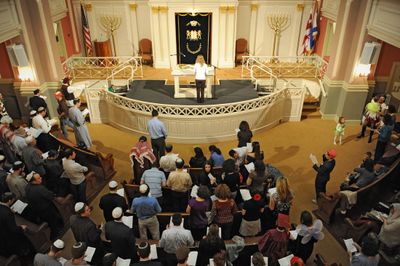New Judaism
Young Jews blend old traditions with modern

Gathering in group homes and college dormitories, in rural woods and apartment buildings, a growing number of young Jews are spurning traditional synagogues.
They’re forming worship communities that blend ancient traditions with modern values in ways that religion scholars say could redefine American Judaism.
The young people represent some of the most devout of their generation. Worried that they are being lost, rabbis and other Jewish leaders are working hard to bring them back into the fold, including offering financial grants to independent groups who are willing to create partnerships with traditional worship communities.
“They are the elite of American Jewish life: the most committed, the most passionate, the most visionary,” said Ari Kelma, a professor of American studies at the University of California at Davis who has studied the young Jews.
“They are going to have a huge impact, because we are living in a moment where denominations are really not very successful, particularly with these 20- and 30-somethings.”
The plight of American Judaism resembles those facing other faiths – including Catholics, evangelicals and mainline Protestants – who are seeing their young drift away from churches.
The proportion of young adults who say they attend services regularly has declined from about one-third in the early 1970s to just over one-quarter now, according to Princeton University religion sociologist Robert Wuthnow.
“I think a lot of people my age don’t want to be in a congregation,” said Shira Ziegler, 22, a biologist who attends services at Tikkun Leil Shabbat.
The independent minyan, or lay-led worship community, meets at churches in Washington, D.C., and draws upward of 200 people on Friday nights.
Many of the young Jews say they prefer not to define themselves according to the large denominations that have traditionally divided Jewish worship life: Reform, the most liberal; Conservative; and Orthodox, the most traditional.
They say they see the partitions as artificially segregating their faith. Instead, they gather in Moishe Houses, a network of group houses where they live and organize worship and social gatherings; in an organization called Jews in the Woods, which meets in rural settings; and in independent minyanim (the plural of the word minyan).
In the D.C. area, a half-dozen minyanim thrive, attracting anywhere from a dozen to hundreds of worshipers each week.
For those who want to learn to lead the complex, Hebrew-language services, DC Minyan matches up beginners with more experienced leaders.
“We really try for a high-spirited and learned community, full of people who know how to do things for themselves, Jewishly speaking,” said attorney Julia Zuckerman, 30, a group leader.
DC Minyan has separate seating for women and men, and uses the Orthodox liturgy, but some worshipers follow along in the Conservative prayer book.
“It is an interesting mix between the egalitarian, pluralistic, inclusive values coming from the left and the values of learning and of observance coming from the right,” said Jonathan Sarna, professor of American Jewish history at Brandeis University.
“They are making a new synthesis of these traditional and modern values that we haven’t seen before.”
Analysts estimate that 20,000 Jews attend the unconventional services each week. While that is a fraction of the estimated 1 million Jews nationwide who regularly attend worship service, researchers say those who attend the services are among the most educated and devout and represent the next generation of Jewish leaders.
Jewish scholars who have studied the groups say independent minyanim members were more likely than typical synagogue-goers to have attended Jewish day school, participated in a youth group, gotten involved in the Jewish college organization Hillel and understand Hebrew.
Still, some researchers question the groups’ future. A previous generation of independent prayer groups started by baby boomers in the 1970s remains active but has stalled in growth.
Some experts wonder whether the current generation of minyanim leaders will move from the urban centers, where most minyanim are based, when they have children and melt into suburban synagogues, which offer extensive educational programs for Jewish children.
After years of indifference or sometimes hostility to independent minyanim, some parts of institutional Judaism are warming to them.
The Conservative denomination recently urged rabbis to provide space for them in synagogues and has offered up to $2,500 to minyan leaders who agree to partner with a Conservative congregation.
One grant recipient is Ruach Minyan, which holds services in a chapel at Adas Israel, the D.C. area’s largest conservative synagogue.
It attracts up to 100 for its lay-led Friday night services, more than the synagogue’s rabbi-led services that go on at the same time.
Gil Steinlauf, Adas Israel’s new senior rabbi, said the synagogue has shifted from merely “tolerating these smaller groups to welcoming them. …
“It’s a radical shift, particularly in this congregation.”